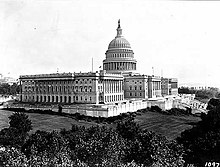
Back كونجرس امريكا ال71 ARZ 71. Kongress der Vereinigten Staaten German Kongres Amerika Serikat ke-71 ID
| 71st United States Congress | |
|---|---|
70th ← → 72nd | |
 United States Capitol (1906) | |
March 4, 1929 – March 4, 1931 | |
| Members | 96 senators 435 representatives 5 non-voting delegates |
| Senate majority | Republican |
| Senate President | Charles Curtis (R) |
| House majority | Republican |
| House Speaker | Nicholas Longworth (R) |
| Sessions | |
| Special[a]: March 4, 1929 – March 5, 1929 1st: April 15, 1929 – November 22, 1929 2nd: December 2, 1929 – July 3, 1930 Special[b]: July 7, 1930 – July 21, 1930 3rd: December 1, 1930 – March 3, 1931 | |
The 71st United States Congress was a meeting of the legislature of the United States federal government, consisting of the United States Senate and the United States House of Representatives. It met in Washington, D.C. from March 4, 1929, to March 4, 1931, during the first two years of Herbert Hoover's presidency. The apportionment of seats in the House of Representatives was based on the 1910 United States census.
Both the House and Senate remained under Republican control, with increased majorities in each chamber. And with Herbert Hoover being sworn in as president on March 4, 1929, the Republicans maintained an overall federal government trifecta.[1][2]
The 71st Congress also featured the most special elections of any Congress with 27 in all.
Cite error: There are <ref group=lower-alpha> tags or {{efn}} templates on this page, but the references will not show without a {{reflist|group=lower-alpha}} template or {{notelist}} template (see the help page).
- ^ Macmahon, Arthur W. (1930). "First Session of the Seventy-First Congress". The American Political Science Review. 24 (1): 38–59. doi:10.2307/1946785. JSTOR 1946785.
- ^ Macmahon, Arthur W. (1930). "Second Session of the Seventy-first Congress, December 2, 1929, to July 3, 1930; Special Session of the Senate, July 7–21". American Political Science Review. 24 (4): 913–946. doi:10.2307/1946750. ISSN 0003-0554. JSTOR 1946750.